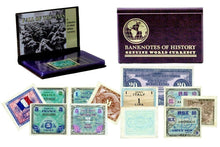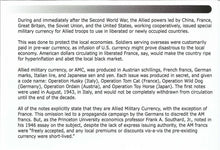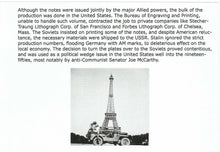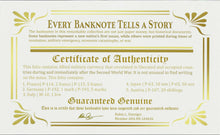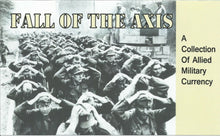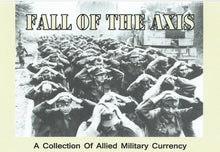
WWII Rare Collection Of Certified Allied Military Currency 8 Banknote Set Album
COA & History & Secure Display Album Incl.Perfect Gift!
History Of Banknotes
During and immediately after the Second World War, the Allied powers led by China, France, Great Britain, the Soviet Union, and the United States, working cooperatively, issued special military currency for Allied troops to use in liberated or newly occupied countries. This was done to protect the local economies. Soldiers serving overseas were customarily paid in pre-war currency, as infusion of U.S. currency might prove disastrous to the local economy. American dollars circulating in liberated France, say, would make the country ripe for hyperinflation and abet the local black market.
Allied military currency, or AMC, was produced in Austrian schillings, French francs,German marks, Italian lire, and Japanese sen and yen. Each issue was produced in secret, and given a code name: Operation Husky (Italy), Operation Tom Cat (France), Operation Wild Dog (Germany), Operation Ordain (Austria), and Operation Toy Horse
(Japan). The first notes were used in August, 1943, in Italy, and would not be completely withdrawn from circulation until the end of the decade. All of the notes explicitly state that they are Allied Military Currency, with the exception of France. This omission led to a propaganda campaign by the Germans to discredit the AM francs. But, as the Princeton University economics professor Frank A. Southard, J r., noted in his 1946 essay on the subject, despite the lack of express issuing authority, the AM francs were “freely accepted, and any local premiums or discounts vis-a-vis the preexisting currency were short-lived.”
(Japan). The first notes were used in August, 1943, in Italy, and would not be completely withdrawn from circulation until the end of the decade. All of the notes explicitly state that they are Allied Military Currency, with the exception of France. This omission led to a propaganda campaign by the Germans to discredit the AM francs. But, as the Princeton University economics professor Frank A. Southard, J r., noted in his 1946 essay on the subject, despite the lack of express issuing authority, the AM francs were “freely accepted, and any local premiums or discounts vis-a-vis the preexisting currency were short-lived.”
Although the notes were issued jointly by the major Allied powers, the bulk of the production was done in the United States. The Bureau of Engraving and Printing, unable to handle such volume, contracted the job to private companies like StecherTraung Lithograph Corp. of San Francisco and Forbes Lithograph Corp. of Chelsea, Mass. The Soviets insisted on printing some of the notes, and despite American reluctance, the necessary materials were shipped to the USSR.
These notes circulated in countries liberated by the Allied military forces in the last days of the Second World War.
Stalin ignored the strict production numbers, flooding Germany with AM marks, to deleterious effect on the local economy. The decision to turn the plates over to the Soviets proved contentious, and was used as a political wedge issue in the United States well into the nineteen-fifties, most notably by anti-Communist Senator Joe McCarthy.
Stalin ignored the strict production numbers, flooding Germany with AM marks, to deleterious effect on the local economy. The decision to turn the plates over to the Soviets proved contentious, and was used as a political wedge issue in the United States well into the nineteen-fifties, most notably by anti-Communist Senator Joe McCarthy.
The Banknotes:
France
• 2 francs, P-114
• 5 francs, P-115
• 2 francs, P-114
• 5 francs, P-115
Germany
• 1 mark, P-192
• 5 marks, P-193
• 1 mark, P-192
• 5 marks, P-193
Italy
• 1 lire, M10
• 1 lire, M10
Japan
• 10 sen, P-63
• 50 sen, P-65
• 10 sen, P-63
• 50 sen, P-65
Austria
• 20 shillings, P-107
• 20 shillings, P-107
A perfect gift for educational purpose or collectors!





